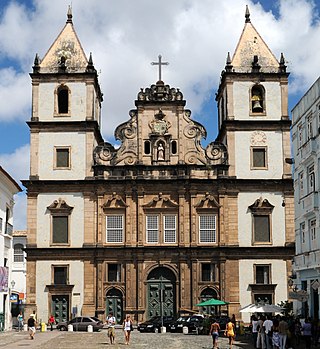
The São Francisco Church and Convent of Salvador is located in the historical centre of Salvador, in the State of Bahia, Brazil. The ornate Church of the Third Order of Saint Francis sits adjacent to the convent. The friars of the Franciscan Order arrived in Salvador in 1587 and constructed a convent and church on the site. This structure was destroyed by the Dutch during the Dutch invasions of Bahia in the next century; Father Vicente das Chagas initiated the current structure in 1686, which was completed in the 18th century. The Franciscan church and convent have the largest number of azulejos, 55,000, of any church in Latin America.
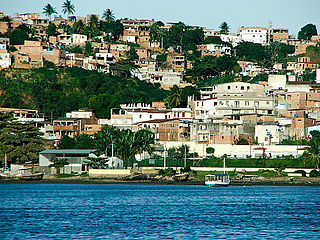
The Itapagipe Peninsula is a peninsula located in the city of Salvador, capital of the Brazilian state of Bahia. The peninsula comprises Administrative Region III, including the neighborhoods of Alagados, Boa Viagem beach, Bonfim, Monte Serrat, Ribeira, Uruguai, Mares, Roma, Caminho de Areia, Vila Ruy Barbosa, and Massaranduba, among others. Rua Fernandes Viêira and Avenida Afrânio Peixoto roughly form a boundary between the peninsula and the city of Salvador. The Church of Our Lady of Penha, one of the earliest structures, occupies the northern tip of the peninsula.
The Parish Church of Our Lady of the Divine Shepherd is an 18th-century Roman Catholic church in the city of Divina Pastora, Sergipe, Brazil. The church venerates the Blessed Virgin Mary under her title Our Lady of the Divine Shepherd, also known as the Divina Pastora. The church is located approximately 39 kilometres (24 mi) from the state capital of Aracaju at the east of the city center of Divina Pastora.

The Church of Our Lady of Penha is an 18th-century Roman Catholic church in Salvador, Bahia, Brazil. The church is located in the Ribeira neighborhood and constructed in 1742 as an extension of the Summer Palace of the Archbishop of the Roman Catholic Archdiocese of São Salvador da Bahia. The church sits at the end of the Itapagipe Peninsula and faces the Bay of All Saints. The Church of Our Lady of Penha was listed as a historic structure by the National Historic and Artistic Heritage Institute in 1941.
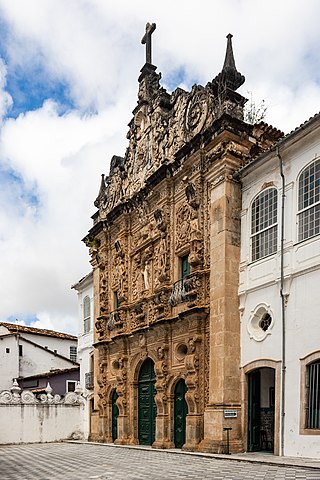
The Church of the Third Order of Saint Francis is an 18th-century Roman Catholic church in Salvador, Bahia, Brazil, and seat of the Third Order of Saint Francis in Brazil. The church is one of the main elements of the Historic Center of Salvador and lies within the UNESCO World Heritage Site of the city. It was listed as a historic structure by National Institute of Historic and Artistic Heritage (IPHAN) in 1941. The church was constructed as an annex to the São Francisco Church and Convent. It is noted for its distinctive Plateresque-style façade, an example unique in Brazil. The writer Jorge Amado called the façade of the Third Order church "magnificent."

The Chapel of Our Lady of Help is a 20th-century Roman Catholic church in Salvador, Bahia, Brazil. It sits on the site of a church of the same name built by the Jesuits in 1549, one of the first in Brazil. The present church was designed by the Italian architect Julio Conti in the Neo-Manueline style and consecrated in 1932. It is owned by the Roman Catholic Archdiocese of São Salvador da Bahia, is dedicated to Our Lady of Help, and houses numerous original works of art of the early colonial period. The Chapel of Our Lady of Help was listed as a historic structure by National Institute of Historic and Artistic Heritage (IPHAN) in 1938 and is part of the Historic Center of Salvador UNESCO World Heritage Site.

The Church of the Third Order of Mount Carmel is an 18th-century Roman Catholic church in Salvador, Bahia, Brazil. It is located adjacent to the Church and Convent of Our Lady of Mount Carmel. Work on the church began in 1644. It was destroyed by fire in 1788 and subsequently rebuilt. The church is a large complex consisting of a nave, chancel, choir, corridors, tribunes, meeting rooms, and a sacristy. The interior was richly decorated in the 18th century; the painting of the ceiling of the nave is the first major work by José Teófilo de Jesus. The Church of the Third Order of Mount Carmel was listed as a historic structure by National Institute of Historic and Artistic Heritage (IPHAN) in 1938 and is part of the Historic Center of Salvador UNESCO World Heritage Site.

The Parish Church of Saint Bartholomew is a 17th-century Roman Catholic church located in Maragogipe, Bahia, Brazil. The church is dedicated to Bartholomew the Apostle and belongs to the Roman Catholic Archdiocese of São Salvador da Bahia.

The Church and Hospice of Our Lady of the Good Journey is an 18th-century Roman Catholic church located in Salvador, Bahia, Brazil. The church is dedicated to Our Lady of the Good Journey and belongs to the Roman Catholic Archdiocese of São Salvador da Bahia. It is located on the Itapagipe Peninsula and faces west directly onto the Bay of All Saints. The Church and Hospice of Our Lady of the Good Journey has a single tower with a frontispiece covered in blue and white azulejos in a zigzag pattern. It was listed as a historic structure by the National Historic and Artistic Heritage Institute (IPHAN) in 1938.

The Parish Church of Our Lady of Pilar is an 18th-century Roman Catholic church located in Salvador, Bahia, Brazil. It includes a cemetery, constructed in the Neoclassical parallel to the nave of the church. The interior of the church has an extensive set of azulejo tiles in the rococo style. The historian Carlos Ott dated them to the late 18th century, and stated that they appear to be the work of the Juncal workshop in Portugal. The stonework of the church is in lioz stone, imported from Lisbon at great expense. The art historian Germain Bazin describes the church as a "refinement of forms", due to its long, narrow nave and lack of corridors in the nave.

The Church of the Third Order of Penitence of Saint Dominic of Osma is an 18th-century Roman Catholic church in Salvador, Bahia, Brazil. The church is dedicated to Saint Dominic, a Castilian priest and founder of the Dominican Order. It belongs to the Roman Catholic Archdiocese of São Salvador da Bahia. It occupies the north-west perimeter of the Terreiro de Jesus, opposite the Cathedral Basilica of Salvador. The church was listed as a historic structure by the National Historic and Artistic Heritage Institute in 1938.

The Church and Convent of Our Lady of the Palm is a 17th-century Roman Catholic church in Salvador, Bahia, Brazil. The church is dedicated to Our Lady of the Palm and belongs to the Roman Catholic Archdiocese of São Salvador da Bahia. The church was established in 1830, and expanded to house members of the Order of Discalced Augustinians in Salvador and their missionaries from other Portuguese colonies. The church has a simple façade and a single bell tower. In contrast, the church has a richly decorated interior, with paintings, images, furniture, and religious implements from the 16th and 17th century. The Church and Convent of Our Lady of the Palm was listed as a historic structure by the National Institute of Historic and Artistic Heritage in 1938.

The Chapel of the Holy Body is an 18th-century Roman Catholic church in Salvador, Bahia, Brazil. The church is dedicated to Saint Peter González; Saint Joseph is also venerated by the congregation. It belongs to the Roman Catholic Archdiocese of São Salvador da Bahia. The church is the seat of the Brotherhood de São José do Corpo Santo, which also manages the property. A large scale image of Our Father of Salvation attributed to Francisco das Chagas is located in the church.

The Church of Saint Michael, formerly known as the Capela do Senhor Bom Jesus da Via Sacra e São Miguel, is an 18th-century Roman Catholic church and former convent in Salvador, Bahia, Brazil. The church is dedicated, as evidenced by its original name, to Our Lord Jesus Crucified of the Via Sacra and Saint Michael the Archange. The church was donated to the Third Order of Saint Francis in 1744. It was listed as a historic structure by the National Historic and Artistic Heritage Institute in 1938.

José Teófilo de Jesus was a Brazilian painter and gilder. He is the most noted representative of the Escola Baiana or Bahian School of painting. His work was eclectic, characterized by the passage from the Baroque to the Rococo, with reference to Neoclassical traits. De Jesus was of pardo, or mixed ethnic ancestry and lived into his nineties; little else is known of his life. His production was apparently vast, but many of his works are only identified by oral tradition. Although he is known as one of the great names of the Brazilian Baroque, and one of its final artists, details of his life and a full account of his works remain unclear.

The Church and Monastery of Our Lady of Grace is an 18th-century Roman Catholic church located in Salvador, Bahia, Brazil. The church is dedicated to Our Lady of Grace and is part of the Roman Catholic Archdiocese of São Salvador da Bahia; it is owned and managed by the Mosteiro de São Bento. It was listed as a historic structure by the National Historic and Artistic Heritage Institute (IPHAN) in 1938.

The Retreat and Church of Our Lady of Humility is a 19th-century Roman Catholic church and women's religious retreat located in Santo Amaro, Bahia, Brazil. It is dedicated to Our Lady of Humility and covers 1,817 square metres (19,560 sq ft). The retreat and church consists of an architectural ensemble of a chapel, a retreat, a seminary, parsonage, forecourt, and side garden. It was listed as a historic structure of the State of Bahia by the IPAC in 1986.
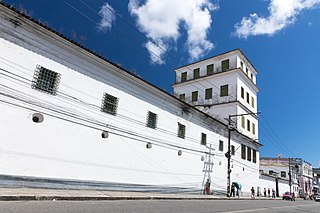
The Church and Convent of Our Lady of the Conception of Lapa (Portuguese: Igreja e Convento de Nossa Senhora da Conceição da Lapa is an 18th-century Roman Catholic church located in Salvador, Bahia, Brazil. The church is dedicated to Our Lady of the Conception and is part of the Roman Catholic Archdiocese of São Salvador da Bahia. It is known as key site in the Brazilian independence movement in the early 19th century. Sister Joana Angélica resisted the invasion of Portuguese troops into the convent and was killed by bayonet in 1822 at the south portal of the convent.
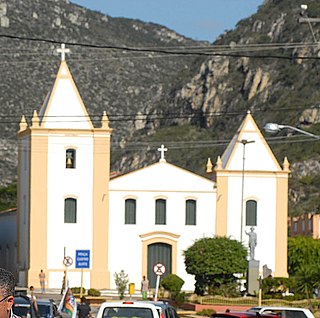
The Parish Church of Saint Antony of Jacobina is an 18th-century Roman Catholic church located in Jacobina, Bahia, Brazil. It was constructed in 1758 and is dedicated to Saint Anthony, and is now part of the Roman Catholic Diocese of Bonfim. It covers 724 square metres (7,790 sq ft). The Institute of Artistic and Cultural Heritage of Bahia listed the church as a state heritage site in 2002.

The Lavagem do Bonfim is an inter-religious celebration that is celebrated in the Brazilian city of Salvador, in the state of Bahia, during the month of January, on the Thursday before the second Sunday after Three Kings' Day. In the same period, there is also a solemn novenary and exposition of the Blessed Sacrament, interrupted only on the day of the washing, when there is a procession between the Basilica of the Conception and the Church of Our Lord of Bonfim, along with the exposition of a small image of Our Lord of Bonfim on the facade of the temple by the church chaplain and a special blessing for all those present. The traditional washing should not be confused with the Festa do Bonfim, event that concludes the novenary on the following Sunday, when mass is celebrated to the saint.
























